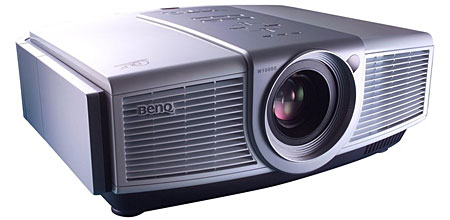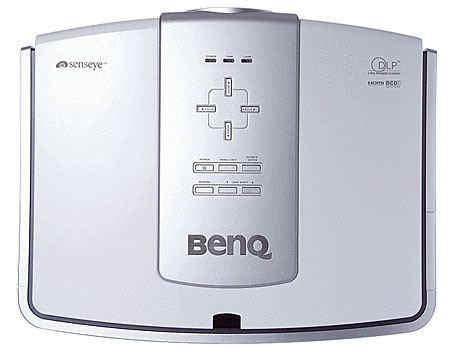BenQ W10000 1080p DLP Projector

Video manufacturers have been severely challenged recently by the drop in prices of all the new technologies. Projectors have not been immune to the pressure. The W10000 is BenQ's first single-chip 1080p projector, coming to market at a time when the prices for such projectors have been slashed beyond all expectations. Can it take the heat?
Around the Block
The W10000 ($9,999 MSRP, $5,999 ESP-BenQ's "Estimated Street Price") isn't a small projector, but it's similar in size to most of the higher-end DLP competition. Physically it's a dead-ringer for the BenQ PE8720 720p projector we reviewed last year. If much of the following sounds like the description of the PE8720, that's because in nearly all respects the feature set in the W10000 is the same. It offers the same motorized zoom, focus and vertical lens shift. Kudos, in particular, to the Focus control. It resists overshooting as long as you don't hold it down continuously, making it easy to nail just the right focus.
While it isn't quite as silent as Sony's SXRD projectors, the W10000 is the quietest DLP projector I've yet tested when the lamp is set to its Whisper Mode (200W). But even with the Whisper Mode Off (250W) it's still admirably quiet.
That relative silence is a good thing, since the W10000, like all the BenQ projectors I've tested, has a very short throw. You'll need to position it between 156.3" and 179.7" from a 100" diagonal 16:9 screen—very close to prime seating positions.
The input set includes two sets of component video connections. One of them, on BNCs, also offers horizontal and vertical sync connections for RGB support. But there is only one HDMI input. Two HDMI inputs are becoming increasingly common on competitive projectors.
The projector does not have a dynamic iris, but does offer a motorized, 20-position iris. But its operation is a bit funky. There are actually more than 20 steps, but not all of them change the setting. And there is no numerical indication of the individual steps, so returning to a previous setting is something of a shot in the dark.
Nevertheless, the flexibility offered by the iris is a real plus. The W10000 is a very bright projector, perhaps the brightest single-chipper we've yet reviewed. The adjustable iris offers great flexibility for different screen sizes and, depending on how hard you push it on screen size, possible reserve output for the inevitable dimming of the lamp.
There are five preset picture modes for each input, plus two User memories for storing your own settings. Additionally, there are two ISF modes: ISF Day and ISF Night. The latter two are designed for an ISF calibrator. Once set up, they are password protected, so you'll always have two properly calibrated setups to fall back on when the babysitter—or the baby—trashes all of your favorite User settings.

The primary video controls are Contrast, Brightness, Color, Tint, Filter, and Sharpness. You can dial in separate settings for each input.
The Filter control is an oddity. The available settings are "0" and "1" for all component and HDMI inputs and resolutions except 480i component, which offers four settings. This control appears to be intended to balance sharpness and noise, but it's only obvious action is to defeat the Sharpness control (Filter setting of 0) or turn Sharpness On (Filter setting of 1). Combining a Filter setting of 1 and Sharpness settings of -1 or -2, for me, produced the best results on most high quality sources.
The Color Temperature control offers four preset settings: Warm, Normal, Cool, and Lamp Native. In addition, there are two memories, User1 and User2. The Advanced menu provides both gain (high) and offset (low) controls for red, green, and blue—the controls required, along with the correct test tools, to perform the calibrations stored in the User memories.
A Color Enhancement control provides individual intensity adjustment for red, green, blue, and yellow, plus white peaking. The only possible use for these controls is to reduce excessive "push" in one of the colors. Unless you have access to an appropriate test pattern (there's one on the Avia Guide to Home Theater test DVD) and suitable filters to view them through, you're better off leaving these controls alone. For this review I left them all in their default positions.
A 3D Color Management feature, also in the Advanced menu, provides Intensity, Hue, and Saturation controls for the primary (red, green, blue) and secondary (yellow, cyan, and magenta) colors. These may be saved into three different Favorite Color memories, which may then be selected through the Picture menu. While the purpose of these controls appears to be to give the uninformed user one more way to mess up the picture, in theory they also appear to provide a means to move the color points to positions that may be more accurate than the factory settings. And they can move the color points, but are not really flexible enough to position them much more precisely than the factory settings (See "Tests and Calibration" for more).
Other controls include a High Altitude setting (which increases the fan speed to compensate for the thinner air at higher elevations), Black Level (0 or 7.5 IRE), Keystone correction (avoid this if you possibly can as all such controls sacrifice resolution), and PIP (picture-in-picture), and POP (picture-outside of-picture). The latter two features are uncommon in front projectors.




























































